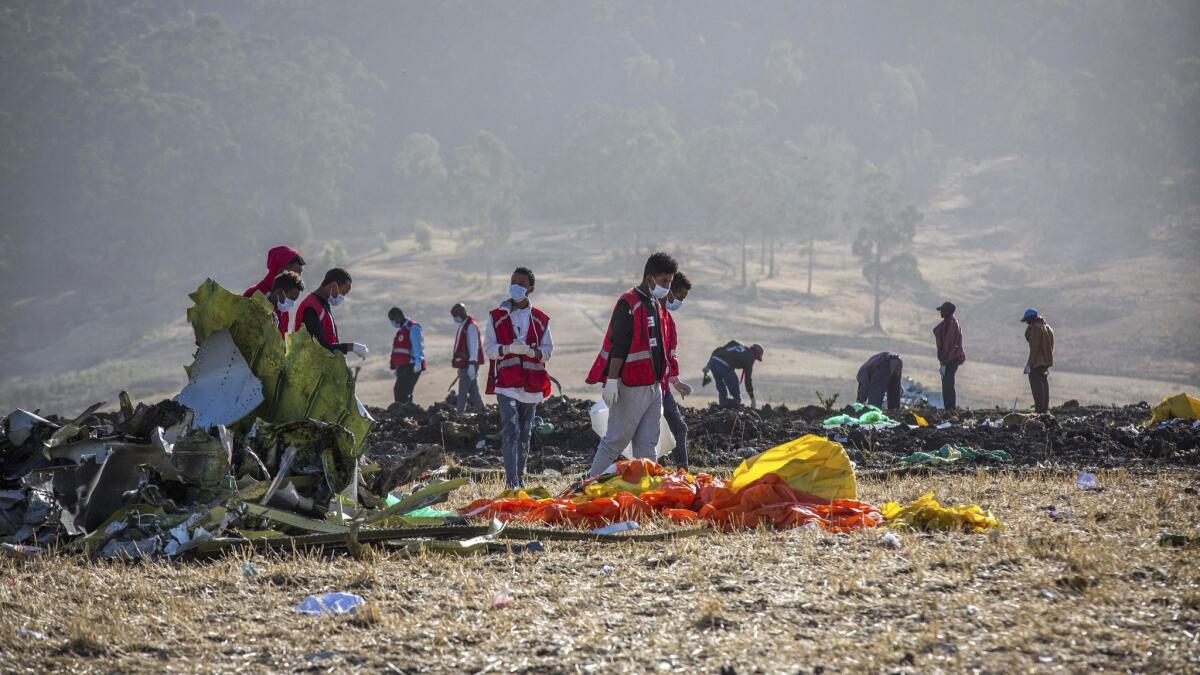Black-box data indicates anti-stalling feature was engaged in Ethiopia crash, official says

- Share via
Investigators scouring black-box data believe that an automatic anti-stalling feature was engaged before a Boeing 737 Max jet crashed and killed 157 people in Ethiopia, a Trump administration official said Friday.
The feature, known as MCAS, also was a factor in the October crash of the same type of aircraft in Indonesia, according to investigators. The investigators said inaccurate information from an outside sensor led MCAS to force the nose of the plane down over and over again.
Pilots proved unable to regain control and prevent disaster, and the Lion Air flight eventually crashed in the Java Sea, killing 189 people.
Boeing on Wednesday detailed a software update it said will make MCAS more reliable and less powerful. They also said all Boeing 737 Max pilots would be required to get new training.
Previous evidence found at the site where Ethiopian Airlines Flight 302 crashed showed that equipment on that 737 Max’s tail was positioned in a way that would push the plane’s nose downward, consistent with the black-box finding.
Experts have also said satellite tracking data showed the Ethiopian Airlines plane taking an unusual upward- and-downward flight path before it crashed, similar to the MCAS issues with the Lion Air crash in Indonesia.
It was those two pieces of evidence that U.S. officials cited in grounding the planes, after most of the rest of the world had already done so.
Investigators have been scouring the Ethiopian Airlines plane’s flight-data recorder to assess whether MCAS played a role in the Ethiopia crash. They were essentially trying to see if on-the-ground evidence was consistent with the detailed technical picture gleaned from the black box.
It was, the administration official said.
That’s important because it helps establish that the plane’s anti-stall technology is, as experts had predicted, implicated in the crash. But the ongoing investigation is also expected to offer insights into the role the pilots themselves played. The information from the black box was first reported by the Wall Street Journal.
Nine days after the Indonesia accident, on Nov. 7, the Federal Aviation Administration issued an international emergency order warning that Boeing had discovered an “unsafe condition” that is “likely to exist or develop” in other planes.
The FAA directive said that if erroneous data is received by the 737 Max jet’s flight control system, the plane’s nose could be pushed down repeatedly. Failing to address that “could cause the flight crew to have difficulty controlling the airplane,” pushing the nose down and leading to “significant altitude loss, and possible impact with terrain,” according to the notice.
The notice told pilots that if bad data causes problems to appear, they should “disengage autopilot” and use other controls to fly the plane.
Ethiopian Airlines officials said their pilots completed all FAA-required training before they began flying the 737 Max jets. Ethiopian’s pilots were also briefed on the FAA directive after the Lion Air crash, the officials said.
Boeing also issued a bulletin Nov. 6 that described how 737 Max pilots should override the automated system suspected of causing the Lion Air crash.
“It begs more questions about why this crew didn’t react properly. … It also begs to ask why did it happen much earlier on this flight than in Indonesia?” said Jeff Guzzetti, a former National Transportation Safety Board investigator and FAA safety manager.
Both flights struggled to gain altitude, and both appeared to ascend and descend before crashing. The Ethiopian Arlines jet’s flight altitude was abnormally low shortly after takeoff from the airport at Addis Ababa. iPreliminary data collected by Flightradar24 suggests that the aircraft, which crashed six minutes after takeoff, failed to climb more than 1,000 feet.
“It was at a lower altitude, much lower altitude. And it was airborne for less than half the time” than the Lion Air jet, Guzzetti said. “That is a difference that needs to be explained.”
By comparison, the Lion Air flight crashed 12 minutes after takeoff from Jakarta. It was supposed to reach a cruising altitude of 27,000 feet, according to the preliminary report, but the aircraft struggled to gain altitude, limiting the crew’s room to gain control before the plane plummeted into the ocean at a reported 450 mph.
As part of their effort to get the planes flying again, Boeing has detailed a software fix that is supposed to address concerns that have been raised about the MCAS system in the preliminary investigation of the Lion Air crash.
Boeing’s update will change how the system previously worked — relying on feeds from two “angle of attack” sensors, rather than the current single sensor, before it engages. In addition, the system will have more limits on how often it engages. Boeing also will make changes that prevent the anti-stall program from angling the plane’s nose too far downward in its attempts to correct for a possible stall.
Michael Laris and Josh Dawsey write for the Washington Post. The Post’s Lori Aratani, Ashley Halsey III and Luz Lazo contributed to this report.
More to Read
Inside the business of entertainment
The Wide Shot brings you news, analysis and insights on everything from streaming wars to production — and what it all means for the future.
You may occasionally receive promotional content from the Los Angeles Times.










